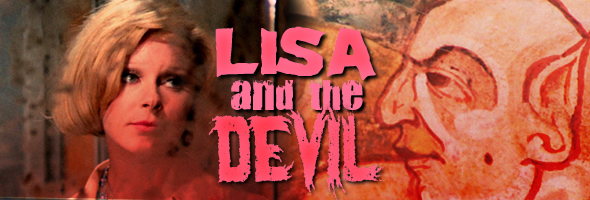

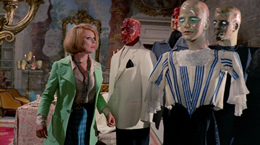 A film both ahead of and behind its time, Mario Bava's 1972 labor of love Lisa and the Devil is easily the challenging and poetic of his impressive streak of horror classics from the '60s and '70s. A nonlinear study of memory, mourning, desire, and damnation, it's closer to the morbid erotic trickery of Last Year at Marienbad than the increasingly graphic horrors unspooling in theaters around the world at the time. That combination of horror and art film eventually came back into vogue as Italian horror grew
A film both ahead of and behind its time, Mario Bava's 1972 labor of love Lisa and the Devil is easily the challenging and poetic of his impressive streak of horror classics from the '60s and '70s. A nonlinear study of memory, mourning, desire, and damnation, it's closer to the morbid erotic trickery of Last Year at Marienbad than the increasingly graphic horrors unspooling in theaters around the world at the time. That combination of horror and art film eventually came back into vogue as Italian horror grew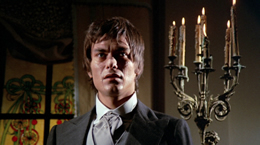 in appreciation during the 1980s, but at the time it proved to be commercially worthless as almost no one indicated any interest in picking up the film for a presumably confused audience. That turned out to be a major heartbreak for both Bava and producer Alfredo Leone, who had fruitfully collaborated earlier on Baron Blood, and with The Exorcist just beginning to play to sold-out crowds in English-speaking countries, something drastic had to be done. The result was The House of Exorcism, which integrated the original film as flashbacks told by a frog-spitting, foul-mouthed possession victim to a confused priest played by Robert Alda. The ploy worked and turned the film into a hit, though that did little to help the career of Bava (who was uncredited in most countries and didn't benefit much with critics who recognized his hand in the production). Both versions have been steadily paired together on DVD since 1999, offering an extreme case study (rivaled perhaps only by the fate of Andzej Zulawski's Possession a few years later) in the often dramatic ways a film can transform thanks to a few reshoots and editorial trickery.
in appreciation during the 1980s, but at the time it proved to be commercially worthless as almost no one indicated any interest in picking up the film for a presumably confused audience. That turned out to be a major heartbreak for both Bava and producer Alfredo Leone, who had fruitfully collaborated earlier on Baron Blood, and with The Exorcist just beginning to play to sold-out crowds in English-speaking countries, something drastic had to be done. The result was The House of Exorcism, which integrated the original film as flashbacks told by a frog-spitting, foul-mouthed possession victim to a confused priest played by Robert Alda. The ploy worked and turned the film into a hit, though that did little to help the career of Bava (who was uncredited in most countries and didn't benefit much with critics who recognized his hand in the production). Both versions have been steadily paired together on DVD since 1999, offering an extreme case study (rivaled perhaps only by the fate of Andzej Zulawski's Possession a few years later) in the often dramatic ways a film can transform thanks to a few reshoots and editorial trickery.
In its original form, Lisa and the Devil concerns the plight of pretty tourist Lisa Reiner (Sommer), who seems to come unstuck from her surroundings and perhaps time itself after viewing a provincial fresco of the devil. She misses her tour bus and finds a ride with the aristocratic Francis and Sophia Lehar (Fajardo and Koscina), who are being chauffeured by Sophia's covert lover, George (Tinti, aka Mr. Laura Gemser). A car breakdown sends them off into the night looking for help at a crumbling villa presided over by a blind Contessa (Valli) and her neurotic son Max (Orano), while the mysterious butler Leandro (Savalas) looks an awful lot like that devil fresco as well as a man Lisa saw earlier that day back in the village. After an uneasy dinner, Lisa pries into the family's past to discover she bears a striking resemblance to Elena, the deceased love of both Max and his father. Soon the bodies begin to pile up, Lisa finds herself sinking deeper into the house's cursed history, and the lollipop-sucking Leandro appears to be more in charge than anyone previously suspected.
As visually sumptuous as any film in Bava's career, Lisa and the Devil feels intensely personal and eerily sincere from the first frames even when the narrative itself threatens to dissolve before your eyes. The logistics of what's happening are less important than how they look and feel, creating more of a tone poem about the haunted relationships between multipl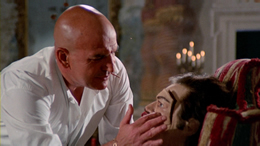 e generations and the inescapable nature of one's past deeds. The marvelous, lushly romantic score by Carlo Savina (largely derived from Rodrigo's popular "Concierto per Aranjuez") accompanies the proceedings perfectly, and for once Sommer is called upon to deliver a genuine, multi-layered performance
e generations and the inescapable nature of one's past deeds. The marvelous, lushly romantic score by Carlo Savina (largely derived from Rodrigo's popular "Concierto per Aranjuez") accompanies the proceedings perfectly, and for once Sommer is called upon to deliver a genuine, multi-layered performance 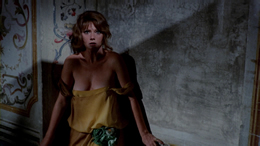 beyond her usual Euro sex kitten roles. Then there's Savalas, offering a charming and wholly unique satanic character who can't really be classified as a villain at all. Another murderous force is loose in the house acting of its own free will, with Savalas simply giving a nudge here and there to keep events on course. The rest of the cast of Italian pros doesn't have quite as much to do, though the always imposing Valli (in between her roles for Luchino Visconti and Dario Argento) makes for a fascinating matriarchal figure.
beyond her usual Euro sex kitten roles. Then there's Savalas, offering a charming and wholly unique satanic character who can't really be classified as a villain at all. Another murderous force is loose in the house acting of its own free will, with Savalas simply giving a nudge here and there to keep events on course. The rest of the cast of Italian pros doesn't have quite as much to do, though the always imposing Valli (in between her roles for Luchino Visconti and Dario Argento) makes for a fascinating matriarchal figure.
Of course this film was far too much for many distributors to handle, and it wound up sitting unloved and unpurchased long enough to send the producer looking for a way to recoup the rather considerable costs (at least compared to most Bava films apart from Danger: Diabolik). The solution: The House of Exorcism, with Sommer returning for new scenes in which Lisa is possessed (exactly by what remains oddly vague) and wheeled off to a hospital where she tells the story of the original film to Alda. This version also reinstated some racier alternate takes of scenes from Lisa, including much more revealing topless exposure for Sommer and Koscina and a gorier version of one nasty murder sequence. Actually, these particular additions aren't bad at all, and in the case of the poker murder, one could argue they actually work better. On the other hand, the new scenes with Sommer (dubbed in possessed form with a voice that will sound familiar to fans of Suspiria's Helena Markos, a name oddly similar to Elena!) and Alda are laughably crude, dragging the film to a halt at random intervals for bouts of awkward cursing and a weirdly gratuitous nude seduction scene. As drive-in fare it's still weirdly entertaining on its own deranged, low-rent terms (and some of the transitions are surprisingly lyrical), but the original Bava film is in a different galaxy entirely.
Along with the even more elusive Rabid Dogs, Lisa and the Devil was basically unseen in its intended form for decades and occupied a strange place in Bava's history. Eventually the original cut began to pop up on late night TV screenings and the bootleg VHS circuit, eventually earning an official release on VHS in the UK from Redemption and on laserdisc from Elite Entertainment as a double feature with the European cut of Baron Blood in 1995. The transfer was problematic even at the time, suffering from rampant video noise, smudgy details, and a weird translucent burlap texture covering the film from start to finish. Still, it was far better than the complete oblivion the film had suffered up to that point. The same transfer was later issued on DVD (still non-anamorphic, natch) from Image Entertainment as a double feature in 1999 with The House of Exorcism, which of course looked far superior in every way. The Image release includes an entertaining audio commentary with Leone and Sommer for The House of Exorcism (which paints a pretty sympathetic portrait of what everyone involved had to go through to get the film into theaters, though their evaluations of the finished product might not synch up with the viewer's), liner notes and a Bava bio by Video Watchdog's Tim Lucas, filmographies, two House of Exorcism theatrical trailers, an poster and stills gallery, a textless theatrical trailer for Lisa and the Devil, and one serious doozy of a video extra missing from all subsequent American DVDs: raw footage of heated, borderline gynecological foreplay between a very u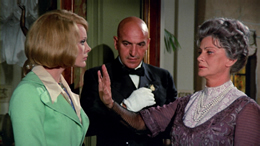 ninhibited Koscina and Tinti, never included in any finished cut of the film. The two versions of the film were also released, minus extras, as standalones from Image.
ninhibited Koscina and Tinti, never included in any finished cut of the film. The two versions of the film were also released, minus extras, as standalones from Image.
When the licensing rights passed over to Anchor Bay for their first Mario Bava box set, they carried over both versions, the commentary, and trailers, dropping the bonus scene in favor of a House of Exorcism radio spot and an excellent Tim Lucas audio commentary or Lisa and the Devil. As he was in the process of writing his definitive epic, Mario Bava: All the Colors of the Dark, this track covers some of the same material as he charts Bava's reasons for making the film including its familial connections, the complicated history behind its transformation into the version most audiences saw in theaters, the invaluable contributors behind the camera (including notes about its impressive art dire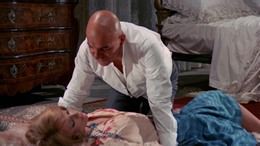 ction), and the seemingly "cursed" nature of the production itself. The transfer of Lisa is completely different here compared to the Image one and, indeed, any other out there. It's anamorphic and far more detailed and film-like, thankfully, though as with the more extreme example of Anchor Bay's blue-drenched Five Dolls for an August Moon, there appears to be some tinkering with the color values and black levels. When seen projected in 35mm (a rare event indeed, so don't miss it if you can!), the film has a delicate, light, almost pastel appearance, with primary colors like red and yellow popping through with an almost gaudy intensity. The Anchor Bay disc tones them down considerably and darkens the image as well, resulting in a more moody and traditionally gothic appearance that's certainly effective but not really all that accurate. This may be attributable to the fact that House of Exorcism has always looked markedly different on film; much of the soft filtering found in Lisa is removed, resulting in a more traditionally sharp film with more naturalistic colors. Perhaps that's why House of Exorcism continues to look more eye-popping on home video, as its appearance aligns more with what people expect films to look like today.
ction), and the seemingly "cursed" nature of the production itself. The transfer of Lisa is completely different here compared to the Image one and, indeed, any other out there. It's anamorphic and far more detailed and film-like, thankfully, though as with the more extreme example of Anchor Bay's blue-drenched Five Dolls for an August Moon, there appears to be some tinkering with the color values and black levels. When seen projected in 35mm (a rare event indeed, so don't miss it if you can!), the film has a delicate, light, almost pastel appearance, with primary colors like red and yellow popping through with an almost gaudy intensity. The Anchor Bay disc tones them down considerably and darkens the image as well, resulting in a more moody and traditionally gothic appearance that's certainly effective but not really all that accurate. This may be attributable to the fact that House of Exorcism has always looked markedly different on film; much of the soft filtering found in Lisa is removed, resulting in a more traditionally sharp film with more naturalistic colors. Perhaps that's why House of Exorcism continues to look more eye-popping on home video, as its appearance aligns more with what people expect films to look like today.
Complicating things further, the Anchor Bay reissue was preceded by less than a year by an Italian DVD (now discontinued) from Raro Video, sporting a completely different anamorphic transfer clos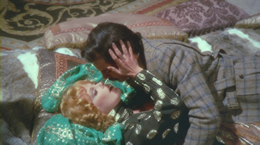 er to Lisa's theatrical appearance but suffering from some weird tiling effects whenever the camera moves (a bugaboo most commonly found in flat transfers bumped up to 16:9). The really fascinating point here is its inclusion of English and Italian audio tracks, albeit without the subtitles in both languages promised on the packaging. The English track actually isn't quite the same as the one found everywhere else; several variations abound, most notably in the final scene which adds lots of screaming and moaning from Sommer running around the airplane and the complete omission of Savalas' final line of dialogue ("Elena..."). The Raro disc also includes a 25-minute video featurette, "The Exorcism of Lisa," with Italian horror biographer Alberto Pezzotta, Lamberto Bava, screenwriter Roberto Natale, and Roy Bava covering the film from conception through production and its mangled release history.
er to Lisa's theatrical appearance but suffering from some weird tiling effects whenever the camera moves (a bugaboo most commonly found in flat transfers bumped up to 16:9). The really fascinating point here is its inclusion of English and Italian audio tracks, albeit without the subtitles in both languages promised on the packaging. The English track actually isn't quite the same as the one found everywhere else; several variations abound, most notably in the final scene which adds lots of screaming and moaning from Sommer running around the airplane and the complete omission of Savalas' final line of dialogue ("Elena..."). The Raro disc also includes a 25-minute video featurette, "The Exorcism of Lisa," with Italian horror biographer Alberto Pezzotta, Lamberto Bava, screenwriter Roberto Natale, and Roy Bava covering the film from conception through production and its mangled release history.
That loops us back around to the third American incarnation, a 2012 Blu-ray and DVD release from Kino Lorber. The Blu-ray understandably improves on its problematic predecessors, containing both versions of the film in their best transfers to date. The Tim Lucas commentary, Sommer/Leone commentary, and trailers and radio spot have been carried over, while one new video addition is "Bava on Bava," a Lamberto Bava interview by Daniel Gouyette (whose fine work can also be found on the same label's line of Jean Rollin Blu-Rays) which covers his memories and working relationship with his father as well as his unorthodox role as assistant director on several of his films (with very different duties on each).
As for the transfers, once again House of Exorcism edges out its competition on the visual front (though by a much slimmer margin than usual), something that will likely be the case for eternity given their cinematic conditions. This version of Lisa veers much closer to the theatrical colors and looks about as impressive as this often soft, powdery-looking film probably could. It also contains the slightly different English audio found on the Italian DVD (omitting Savalas' final superfluous spoken word, which arguably works better). 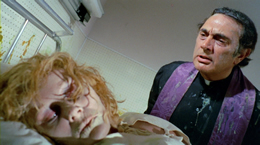 Interestingly, the presentation of House of Exorcism has slightly more naturalistic colors but is more tightly framed on the right and bottom edges; the biggest difference between the two transfers on this disc is, surprisingly, the color blue, which veers into '60s "electric" territory at times but remains more subdued on the Exorcism cut. It's difficult to notice outside of watching both in motion, but for a basic comparison, check out this shot from Lisa (note: the whites throughout most of the film look like the rest of the frame grabs here) and this same moment from Exorcism. Different viewers will probably have unique responses to both, but if you see the two films screened theatrically, the same disparity usually exists as well. In any case, it's a recommended upgrade for one of Bava's most haunting and adventurous films paired with a variation still capable of stirring up controversy today.
Interestingly, the presentation of House of Exorcism has slightly more naturalistic colors but is more tightly framed on the right and bottom edges; the biggest difference between the two transfers on this disc is, surprisingly, the color blue, which veers into '60s "electric" territory at times but remains more subdued on the Exorcism cut. It's difficult to notice outside of watching both in motion, but for a basic comparison, check out this shot from Lisa (note: the whites throughout most of the film look like the rest of the frame grabs here) and this same moment from Exorcism. Different viewers will probably have unique responses to both, but if you see the two films screened theatrically, the same disparity usually exists as well. In any case, it's a recommended upgrade for one of Bava's most haunting and adventurous films paired with a variation still capable of stirring up controversy today.
However, that wasn't the end of the road for Lisa on home video; a 2013 Blu-ray/DVD combo release in the UK from Arrow manages to sweeten the deal by carrying over both versions (in what appear to be identical transfers to the Kino release) but adding optional English subtitles to both cuts and - finally! - presenting the excellent Italian audio track for Lisa and the Devil with its own newly translated English subtitles as well. It's a bit of a toss up as to which version comes out ahead; the English one has Savalas' voice which accounts for at least half of his marvelous performance, but the Italian version has a subtlety and a literary quality that's far more pronounced and appropriate to the tone of the film. Watch 'em both; you won't be sorry either way. The Italian track would actually be enough to justify an upgrade alone, but in addition to the other familiar extras (both the Lucas and Sommer/Leone commentaries, the trailers, and radio spot), you get the return of that temporarily suppressed deleted sex scene, the complete "Exorcism of Lisa" featurette from the Italian release with English subtitles, an additional House of Exorcism U-Certificate trailer from the UK, and short but very informative video introductions from Italian horror expert Alan Jones (preceded this time by the Nucleus Films logo) for both versions, sketching out in about three minutes each the tangled story behind the making (including its inspiration from Dostoyevsky, Lovecraft, and Psychopathia Sexualis), unmaking, and resurrection of one of Mario Bava's most personal and deeply affecting masterworks.
![]()